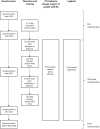Physiotherapists' Adoption of a Theory-Based Skills Training Program in Guiding People with Rheumatoid Arthritis to Health-Enhancing Physical Activity
- PMID: 29971578
- PMCID: PMC6061243
- DOI: 10.1007/s12529-018-9716-1
Physiotherapists' Adoption of a Theory-Based Skills Training Program in Guiding People with Rheumatoid Arthritis to Health-Enhancing Physical Activity
Abstract
Purpose: To describe physiotherapists' (PTs') adoption of a theory-based skills training program preparing them to guide people with rheumatoid arthritis (RA) to health-enhancing physical activity (HEPA) within a 1-year intervention trial.
Method: This was a longitudinal case study. Ten female PTs (age 25-59), delivering the HEPA intervention, participated. Data were collected on five occasions over a 19-month period: once before the training course, once after 4 course days, twice during the HEPA intervention and once after the HEPA intervention. Knowledge on about physical activity (score 0-6) and behavior change techniques (BCTs) (score 0-18), fear-avoidance beliefs (score 8-48) and self-efficacy to guide behavior change (score 9-54) were assessed with a questionnaire. Structured logbooks were used to register PTs' self-reported guiding behavior. Criteria for PTs' adherence to the protocol were pre-set.
Results: PTs' knowledge on about BCTs and their self-efficacy increased significantly (p < 0.05) from median 9 to 13 and from median 38 to 46.5, respectively. Knowledge on about physical activity was high and fear-avoidance beliefs were low before the education (median 6 and 13.5, respectively) and did not change over time. Two out of ten PTs fulfilled the pre-set criteria for adherence throughout the intervention.
Conclusion: The results suggest that a theory-based skills training program improves PTs' knowledge on about behavior change techniques and their self-efficacy to guide people with RA to HEPA. PTs' adherence to the protocol was not complete but the clinical relevance of the adherence criteria need to be validated against observed PT behavior and patient outcomes.
Keywords: Adherence; Behavior change techniques; Education; Fear-avoidance beliefs; Intervention; Physical activity; Physical therapist; Self-efficacy.
Conflict of interest statement
The authors declare they have no conflict of interest.
Figures



Similar articles
-
Physiotherapists' management of challenging situations in guiding people with rheumatoid arthritis to health-enhancing physical activity.Physiother Theory Pract. 2019 Jan;35(1):31-39. doi: 10.1080/09593985.2018.1434847. Epub 2018 Feb 15. Physiother Theory Pract. 2019. PMID: 29447492
-
An outsourced health-enhancing physical activity programme for people with rheumatoid arthritis: exploration of adherence and response.Rheumatology (Oxford). 2015 Jun;54(6):1065-73. doi: 10.1093/rheumatology/keu444. Epub 2014 Nov 27. Rheumatology (Oxford). 2015. PMID: 25433043 Free PMC article.
-
Physical therapists' assessments, analyses and use of behavior change techniques in initial consultations on musculoskeletal pain: direct observations in primary health care.BMC Musculoskelet Disord. 2016 Jul 27;17:316. doi: 10.1186/s12891-016-1173-x. BMC Musculoskelet Disord. 2016. PMID: 27464877 Free PMC article.
-
Sustainable implementation efforts in physio- and occupational therapy: a scoping review.Implement Sci Commun. 2024 Dec 12;5(1):138. doi: 10.1186/s43058-024-00676-8. Implement Sci Commun. 2024. PMID: 39668369 Free PMC article.
-
Physical Therapists' and Physical Therapist Students' Experiences and Views on the Provision of Physical Therapy Services to People With Dementia: A Scoping Review.J Geriatr Phys Ther. 2022 Jul-Sep 01;46(3):174-182. doi: 10.1519/JPT.0000000000000351. Epub 2022 Apr 8. J Geriatr Phys Ther. 2022. PMID: 35420572
Cited by
-
"A Necessary Investment in Future Health": Perceptions of Physical Activity Maintenance Among People With Rheumatoid Arthritis.Phys Ther. 2020 Dec 7;100(12):2144-2153. doi: 10.1093/ptj/pzaa176. Phys Ther. 2020. PMID: 32975562 Free PMC article.
-
Measures of self-regulation used in adult rehabilitation populations: A systematic review and content screening.Clin Rehabil. 2022 Aug;36(8):1120-1138. doi: 10.1177/02692155221091510. Epub 2022 Apr 27. Clin Rehabil. 2022. PMID: 35473388 Free PMC article.
-
Theory-informed interventions to promote physical activity and reduce sedentary behaviour in rheumatoid arthritis: a critical review of the literature.Mediterr J Rheumatol. 2020 Mar 31;31(1):19-41. doi: 10.31138/mjr.31.1.19. eCollection 2020 Mar. Mediterr J Rheumatol. 2020. PMID: 32411931 Free PMC article. Review.
References
-
- Haskell W, Lee I, Pate R, Powell K, Blair S, Franklin B, et al. Physical activity and public health: updated recommendation for adults from the American College of Sports Medicine and the American Heart Assocation. Med Sci Sports Exerc. 2007;39:1423–1434. doi: 10.1249/mss.0b013e3180616b27. - DOI - PubMed
-
- Nelson M, Rejeski W, Blair S, Duncan P, Judge J, King A, Macera CA, Castaneda-Sceppa C. Physical activity and public health in older adults: recommendations from the American College of Sports Medicine and the American Heart Association. Med Sci Sports Exerc. 2007;39:1435–1445. doi: 10.1249/mss.0b013e3180616aa2. - DOI - PubMed
-
- Michie S, Richardson M, Johnston M, Abraham C, Francis J, Hardeman W, Eccles MP, Cane J, Wood CE. The Behavior Change Technique Taxonomy (v1) of 93 hierarchically clustered techniques: building an international consensus for the reporting of behavior change interventions. Ann Behav Med. 2013;46:81–95. doi: 10.1007/s12160-013-9486-6. - DOI - PubMed
MeSH terms
LinkOut - more resources
Full Text Sources
Other Literature Sources
Medical

